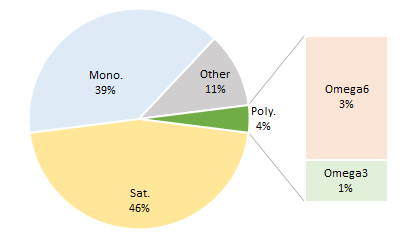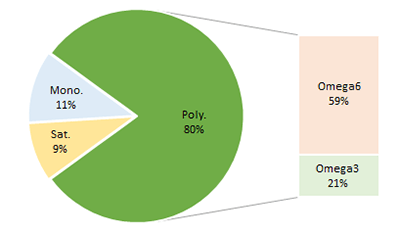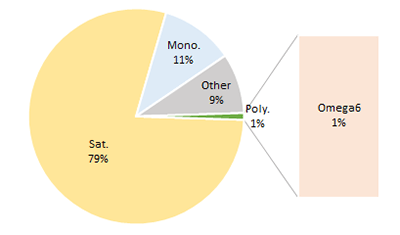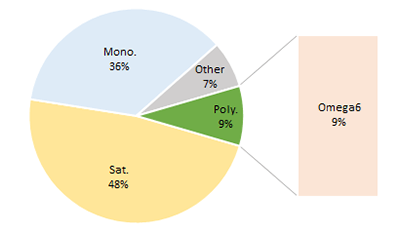What Is the Smoke Point of Beef Fat
All cooking fats and oils are made up of saturated, polyunsaturated and monounsaturated fatty acids in different proportions.
This page provides a breakdown of information about twenty of the most commonly used cooking oils and fats, including their fat type proportions and smoke points.
Generally, oils and fats with a high proportion of saturated fat are less healthy than those with higher poly and mono unsaturated fats.
Polyunsaturated fats can help lower cholesterol, omega-3 polyunsaturates may help protect against heart disease and omega-6 fatty acids may help with growth and brain function.
Monounsaturated fats can also help lower cholesterol if they replace saturated fats. Monounsaturated fats may also help decrease the risk of breast cancer and rheumatoid arthritis pain.
Quick Tip:
Generally, choose cooking oils and fat with low saturated fat and a good mix of mono and poly unsaturated fats. On our graphs look for less red (saturated) and a good mix of blue and green (mono and poly unsaturated fats).
See our page: What is Fat? for more background information on fat and its role in diet and nutrition.
Smoke Point
The smoke point of an oil or fat is the temperature at which it starts to burn and degrade – oils and fats with a higher smoke point are more suited to frying food than those with lower smoke points, which are more suited for cold use - such as in salad dressings.
Fat type proportions and smoke points vary for the same type of oil depending on how it has been processed and/or produced. How oil is stored and used also effects its qualities - as oils are reused, in deep frying for example, they degrade. When not in use, most oils should be kept cool, in air tight containers and out of direct sunlight for maximum longevity. For these reasons the figures on this page are for general guidance and only apply to fresh, high-quality oils. Check the label or contact the manufacturer of specific oil or fat products for more precise data.

Alphabetical list of common fats and oils:
The following tables show more information about each of our twenty common cooking fats and oils. The title bar of each table is shaded to show the predominant fat type: red for saturated, green for monounsaturated and blue for polyunsaturated fat. Each pie chart displays the percentage value of each type of fat - expanding the polyunsaturated fats to show the proportions of omega-6 and omega-3 fatty acids. Most oils and fats contain 'other' things, for example butter contains proteins as well as fats, and these are included in the 'other' segment of the pie charts.
Are we missing something? Please get in touch to tell us what you think.
| Beef Fat (dripping) | |
 | Smoke Point: 275oC | 540oF Predominant Fat Type: |
| Similar to lard (pork fat), beef fat was once common in British cuisine, although now has been mostly replaced by healthier vegetable oils. Beef fat is still sometimes used for frying fish and chips, making Yorkshire puddings and beef gravy, amongst other things. 'Dripping', the solidified fat left over from roasting beef, was traditionally spread on bread as a substitute for butter or margarine, often with added salt. Beef fat has a very high smoke point. | |
| Butter | |
 | Smoke Point: 175oC | 350oF Predominant Fat Type: |
| Used widely in cooking, for frying, baking and as a spread, butter is considered a staple food in many countries. Butter is most commonly made from cow's milk although can be produced from the milk of other mammals, like goats and buffalo. Being derived from animal sources (dairy), butter is high in saturated fat. Butter is also often salted to improve the flavour when used as a spread. Butter is not suitable for vegan diets. Many people substitute margarine for butter believing it to be more healthy, however not all margarines are created equal. Be careful to choose margarines that contain no hydrogenated or trans fats and that have a low saturated fat content, otherwise butter may well be better for you. | |
| Chicken Fat | |
 | Smoke Point: 205oC | 400oF Predominant Fat Type: |
| Despite being an animal fat, chicken fat contains more monounsaturated fats than saturated. Nevertheless, chicken fat is still relatively high in saturated fats compared to some vegetable alternatives. Chicken fat is used for its flavour to make chicken stock, which in turn is used in soups, sauces and gravies. Chicken fat can be a rich source of omega fatty acids, especially omega-6. As an animal fat it is not suitable for vegetarian or vegan diets. | |
| Cocoa Butter | |
 | Smoke Point: 205oC | 400oF Predominant Fat Type: |
| Used mainly in the production of chocolate, cocoa butter is extracted from the cocoa bean and contains high levels of saturated fat. Although there is the same about of fat in both dark and milk chocolate, dark chocolate contains more antioxidants and is less sweet. It is therefore usually eaten in smaller quantities. | |
| Coconut Oil | |
 | Smoke Point: 175oC | 350oF Predominant Fat Type: |
| Extracted from the flesh of the coconut, the seed of the coconut palm tree, coconut oil is very high in saturated fat (92%). However, despite its high saturated fat content coconut oil is not unhealthy. Unlike saturated fats from animal sources that are made up of predominately long-chain triglycerides (LCT), the type of saturated fat associated with health problems and weight gain, coconut oil has a high proportion of medium-chain triglycerides (MCT). MCTs are lighter and more soluble than LCTs and are not digested by our bodies. They are directly absorbed into blood and are not stored as body fat. The body processes MCTs and can use them for instant energy and an alternative to glucose from carbohydrates. Coconut oil is often used in curries and other dishes from The Caribbean and Southern Asia, especially in Thai food. With thanks to Dr. Sylvia Mitchell, University of the West Indies. | |
| Corn (maize) Oil | |
 | Smoke Point: 230oC | 450oF Predominant Fat Type: |
| Relatively low in saturated fats and a good source of omega-3, 6 and 9 fatty acids, corn oil is a popular choice for cooking. Furthermore, corn oil tends to be inexpensive and, due to its high burn or smoke point, is commonly used for fried food – especially deep-fat frying. | |
| Cotton Seed Oil | |
 | Smoke Point: 220oC | 420oF Predominant Fat Type: |
| Cotton seed oil is common in many foodstuffs from salad dressings and mayonnaise to many processed foods, especially in the US where it is an inexpensive alternative to other oils. Most famously, cotton seed oil is traditionally the main component of Crisco vegetable shortening. | |
| Ghee | |
 | Smoke Point: 250oC | 480oF Predominant Fat Type: |
| Ghee is a type of clarified butter commonly used in, and associated with, the cuisine of the Indian sub-continent. Ghee's quality can vary considerably depending on the type of butter used and the production method. Unlike butter, ghee does not need to be refrigerated and has a long shelf-life when kept in an air-tight container. Ghee has a higher overall fat content than butter and higher levels of saturated fat. | |
| Hemp Oil | |
 | Smoke Point: 165oC | 330oF Predominant Fat Type: |
| Boasting low saturated fat and high levels of omega-6 fatty acids, hemp oil is a healthy choice. Due to its low smoke point hemp oil is not usually suited for frying food but, with its nutty taste, can be ideal for salad dressings. Quality hemp oil is extracted from hemp seeds by cold pressing – meaning crushing the seeds at an ambient temperature. Heavily processed hemp oil loses a lot of its natural flavour and beneficial qualities. | |
| Olive Oil (extra virgin) | |
 | Smoke Point: 160oC | 320oF Predominant Fat Type: |
| Associated with the Mediterranean but now commonly available elsewhere, olive oil is known to be a healthier alternative to many other types of cooking oils and fats. Olive oil is rich in vitamin E and other compounds known to help protect against certain diseases and can be beneficial to cholesterol levels. Olive oil is often considered to be a 'premium oil' due to its high price. Virgin and extra-virgin olive oils offer the best health benefits as they are less refined than light or extra light varieties. The flavour and quality of olive oil depends on similar conditions to wine - the variety of olive used, the region, climate and the method of cultivation and harvest. Extra virgin olive oil has a low smoke point and is not usually used for frying food. | |
| Palm Kernel Oil | |
 | Smoke Point: 330oC | 450oF Predominant Fat Type: |
| Palm kernel oil is extracted from the kernel of the oil palm tree. It shares similar qualities with, but is not the same as, palm oil which is extracted from the oil palm fruit. Palm kernel oil is high in saturated fat. Due to its low price and high smoke point it is used frequently in fast food and other commercial cooking. | |
| Palm Oil | |
 | Smoke Point: 225oC | 440oF Predominant Fat Type: |
| Palm oil is commonly used in tropical countries for cooking – especially in Africa, South East Asia and parts of South America. Naturally palm oil is a rich red colour as it contains high levels of beta-carotene although it is often processed to remove a lot of the colour. Although palm oil comes from the same tree as palm kernel oil it is significantly lower in saturated fat. | |
| Peanut (groundnut) Oil | |
 | Smoke Point: 225oC | 440oF Predominant Fat Type: |
| Used commonly in Chinese cookery, peanut oil is derived from refining peanuts. Usually, in the West, commercially available peanut oil has been through a rigorous refining process, which removes allergens from the oil and so such oil is usually safe for people with peanut allergies to use. However cold-pressed peanut oil, a less refined alternative, can be potentially dangerous to peanut allergy sufferers. | |
| Pork Fat (lard) | |
 | Smoke Point: 190oC | 375oF Predominant Fat Type: |
| Pork fat, commonly known as lard, was traditionally used as a cooking fat or alternative to butter in a similar way to beef fat or dripping. Lard is less frequently used today as healthier vegetable oils are usually preferred – however lard is still used in parts of Europe and favoured by some cooks because of its flavour. As with all fats derived from animal sources, lard is relatively high in saturated fat but has a higher proportion of monounsaturated fat. As an animal fat, lard is not suitable for vegetarian or vegan diets. | |
| Rapeseed (Canola) Oil | |
 | Smoke Point: 205oC | 400oF Predominant Fat Type: |
| Oilseed rape is a member of the brassica family of plants, which also includes cabbage, broccoli, turnips and mustard. The word 'rape' is derived from the Latin for turnip. With only 7% saturated fat, rapeseed oil is considered one of the healthiest types of culinary oils available. Rapeseed oil also has relatively high concentrations of omega-3 and omega-6 fatty acids. In the UK, rapeseed oil has become very trendy over recent years with increasingly large parts of the countryside taken up with growing oilseed rape. Rapeseed oil is often a key ingredient of the generically termed 'vegetable oil' in the UK due to its unfortunate name. In North America the oil is usually referred to as 'Canola', the name deriving from a cultivar of the rapeseed plant. | |
| Rice Bran Oil | |
 | Smoke Point: 255oC | 490oF Predominant Fat Type: |
| Rice bran oil, extracted from the husk of rice, is commonly used for Asian cookery, especially in Chinese and Japanese dishes. Rice bran oil is rich in complex compounds, with a good balance of both mono and poly unsaturated fats and known to be of benefit to health - it may help to lower blood cholesterol. Rice bran oil does however contain 25% saturated fat. The oil has a high smoke point and is used for deep fat frying and stir frying. | |
| Safflower Oil | |
 | Smoke Point: 230oC | 450oF Predominant Fat Type: |
| Safflower oil comes from the seeds of the safflower plant, which resembles a thistle with a yellow flower. There are two main types of safflower oil, one that contains mainly monounsaturated fat and one that contains mainly polyunsaturated. The polyunsaturated version is the most beneficial to health and most commonly used for cooking. Despite its long history, dating back at least as far as the ancient Egyptians, the plant and oil are not common although there has been renewed interest in recent years. | |
| Sesame Oil | |
 | Smoke Point: 210oC | 410oF Predominant Fat Type: |
| Used as a cooking oil and flavour enhancer in Southern India, China, Korea and other parts of Asia, sesame oil is extracted from sesame seeds. Sesame oil is relatively low in saturated fats has a good mix of mono and polyunsaturated fats with high levels (40%) of omega-6 fatty acid and can be a valuable source of vitamin E. | |
| Soya Bean Oil | |
 | Smoke Point: 230oC | 450oF Predominant Fat Type: |
| Extracted from the seeds of the soya bean, soya bean oil accounts for around 80% of all commercial oil used in the US and around a third of all edible oil worldwide. Soya bean oil is commonly hydrogenated and used in a variety of processed foods; the hydrogenated oil has much more saturated fat than the un-hydrogenated version. Soya bean oil is usually used in baking and in the production of commercial, processed foods. | |
| Sunflower Oil | |
 | Smoke Point: 230oC | 450oF Predominant Fat Type: |
| Sunflower oil is produced by pressing sunflower seeds. Sunflower oil contains only 10% saturated fat and a high proportion of polyunsaturated alpha-linoleic acid (Omega-6). Sunflower oil is versatile, has a high burn or smoke temperature and is relatively inexpensive, especially in the West. Commercially sunflower oil has become more widely used in recent years, especially in the production of potato crisps (chips). | |
Also...
Vegetable Oil
Vegetable oil is a generic term used to describe cooking oil derived from vegetable sources. It is generally lower in saturated fats than animal based fats and oils and is commonly used for frying food, baking and other cooking. As vegetable oil is often a blend of different types of oil it is not possible to determine the ratio between the different types of fat. Labels on different vegetable oil products may give some clue as to the type of oils used and their relative fat contents. In the UK rapeseed oil is often labelled as vegetable oil.
Margarine
Margarine is typically used as a substitute for butter, for spreading on bread and in baking. There are many different brands of margarine containing different blends of oils and fats. Avoid buying any margarine with 'trans' or hydrogenated fats as these are particularly bad for you. Research has suggested that margarines containing plant sterols and stanols can help to reduce blood cholesterol by as much as 10% and therefore these may be beneficial for some people. Such margarines may not be suitable for children though, so always read the label carefully.
TOP
Source: https://www.skillsyouneed.com/ps/fats-oils.html
0 Response to "What Is the Smoke Point of Beef Fat"
Post a Comment